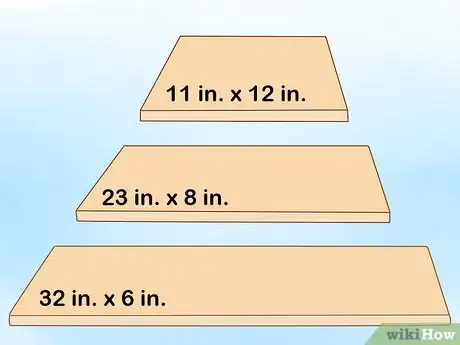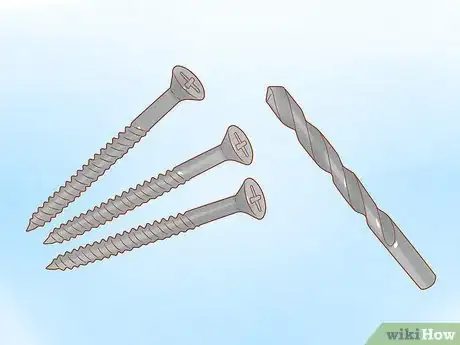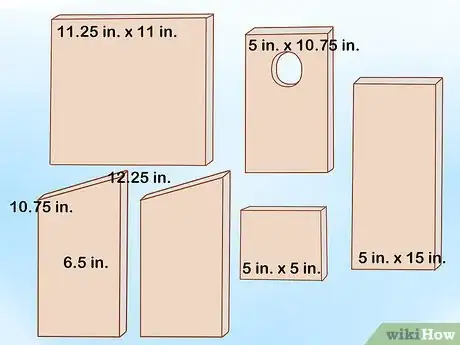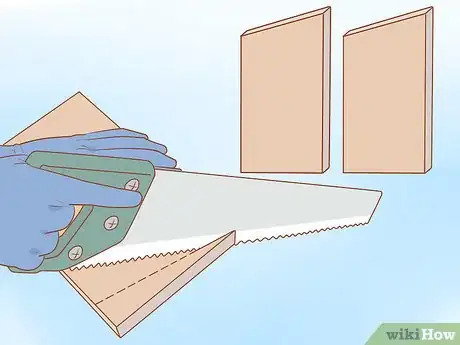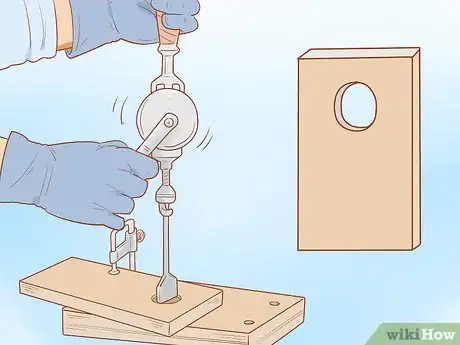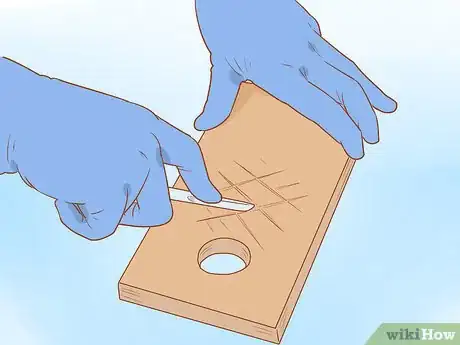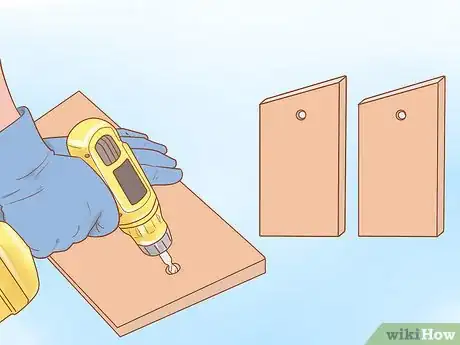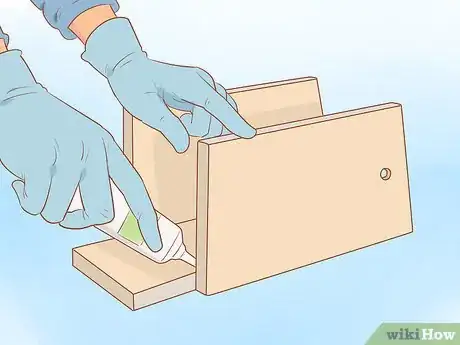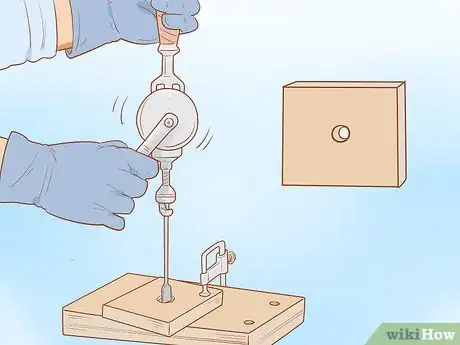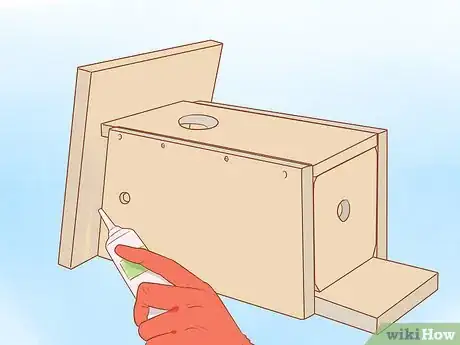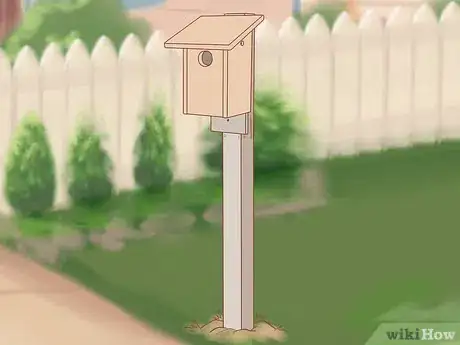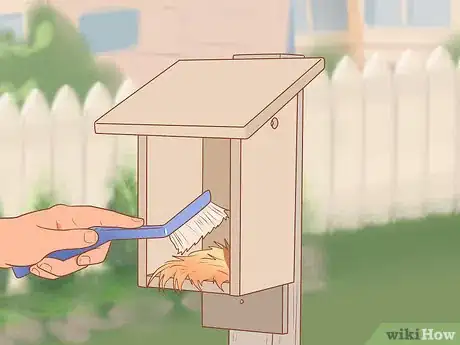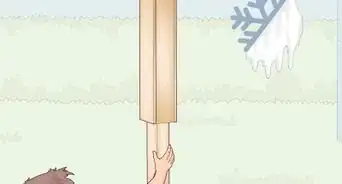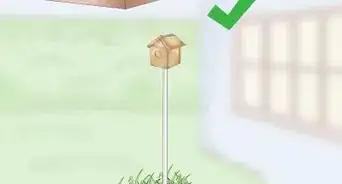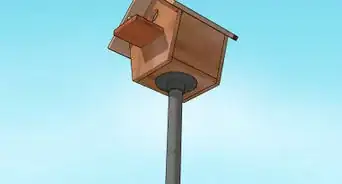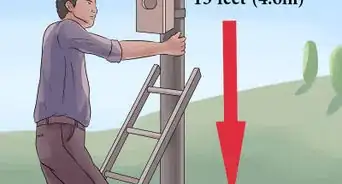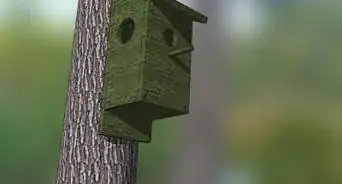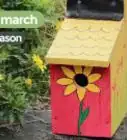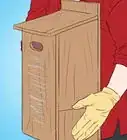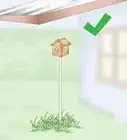This article was co-authored by wikiHow Staff. Our trained team of editors and researchers validate articles for accuracy and comprehensiveness. wikiHow's Content Management Team carefully monitors the work from our editorial staff to ensure that each article is backed by trusted research and meets our high quality standards.
wikiHow marks an article as reader-approved once it receives enough positive feedback. This article received 17 testimonials and 93% of readers who voted found it helpful, earning it our reader-approved status.
This article has been viewed 434,239 times.
Learn more...
The Eastern Bluebird, also known as Sialia sialis, is a member of the thrush family. It is larger than a sparrow but smaller than a blue jay and can be found everywhere from Canada to the Gulf States and East of the Rockies. With the right pieces of wood and some basic power tools, you can build a house for this beautiful bird and give it a place to stay in your yard.
Steps
Gathering Your Materials
-
1Cut 3 pieces of wood from a piece of 1 in (2.5 cm) thick unfinished wood. Start by purchasing a 66 inch (170 cm) long piece of 1 in (2.5 cm) thick unfinished wood. Now, cut it into 3 pieces: one 11 in (28 cm) piece of 1 in × 12 in (2.5 cm × 30.5 cm) wood for the roof; one 23 in (58 cm) piece of 1 in × 8 in (2.5 cm × 20.3 cm) wood for the sides; and one 32 in (81 cm) piece of 1 in × 6 in (2.5 cm × 15.2 cm) wood for the back and front. Although you can choose pretty much any kind of wood you want, white pine and cedar are the easiest to find.[1]
- Don't use plywood or particleboard.
-
2Buy glue made from aliphatic resin, urethane, or construction adhesive. Make sure you purchase one of these glue types to ensure that your bluebird house stays together in the long-term. Standard glues are not strong enough for the needs of a bluebird house.[2]
- If you use a urethane-based glue, such as Gorilla glue, be sure to secure the joints with screws before it dries.
Advertisement -
3Purchase 10 exterior grade 2 inch (5.1 cm) screws. Using these screws you will drill 4 in the front, 4 in the back, and 2 to secure the base. Purchase all of these from the local hardware store or online supplier. If you don't have an electric drill, purchase one as well.[3]
- Purchase a twist bit to pre-drill the holes. These also create a countersink, which is the indentation that the screw head sits in.
- If you have the money, purchase 2 drills to avoid switching drill bits.
-
4Cut the wood pieces into the necessary bluebird parts. The 11.25 by 11 inch (28.6 cm × 27.9 cm) piece doesn't need to be cut. Use a circular saw and ruler to measure and cut your remaining 2 pieces of wood into the bluebird parts listed below. You can also use a bandsaw if you have access to one. If you don't feel comfortable cutting the pieces on your own, pay someone at the local hardware store or lumberyard to create the specific dimensions you need. Regardless, you should have 6 pieces of wood at the end:[4]
- Two side pieces 6.5 in (17 cm) wide, angled 12.25 in (31.1 cm) top to bottom in the back and 10.75 in (27.3 cm) in the front.
- One front piece 5 in (13 cm) wide and 10.75 in (27.3 cm) tall.
- One bottom piece 5 in (13 cm) long and wide
- One back piece 5 in (13 cm) wide and 15 in (38 cm) long.
-
5Angle the side pieces diagonally from the top to bottom. The top of the side pieces of the bluebird houses angle downward to create a sloped roof. The back end of the pieces are 12.25 in (31.1 cm) tall and the front ends are 10.75 in (27.3 cm). If you're cutting wood on your own, start with 12.25 in (31.1 cm) tall side pieces and mark the spot 1.5 in (3.8 cm) down from the top on each opposing side. Cut from the top of the tall side in a straight line down to the marked spot on the opposing side to create the angle.[5]
- Use a ruler to draw a cutline from one 12.25 inch (31.1 cm) side to the opposing side 1.5 inches (3.8 cm) downward.
Putting Your Bluebird House Together
-
1Create a 1.5–1.5625 inch (3.810–3.969 cm) entrance hole in the front piece. The hole should be placed 2 inches (5.1 cm) from the top of the wood and 2.5 inches (6.4 cm) from both sides. Use a spade bit, hole saw, or adjustable size hole bit with your drill to create the hole. For best results, drill the hole about 3/4 of the way through, flip the board, and finish the hole by drilling through the reverse side.[6]
- For western bluebirds or eastern bluebirds, drill a 1.5 inch (3.8 cm) hole. For mountain bluebirds, create a 1.5625 inch (3.969 cm) hole.
-
2Create deep crisscrossed scratches on both sides of the panel. Use a chisel, nail, or knife to create crisscrossed scratches running from the entrance hole to the bottom on both sides of the front piece. This will give young birds traction to climb to the hole and easily leave the nest. It will also give the mother something to land on.
-
3Drill a 5⁄8 in (1.6 cm) ventilation holes in each of the side pieces. Each side piece's ventilation hole should be 1 in (2.5 cm) down from the top of the wood and 2 in (5.1 cm) from both sides. Attach a 5⁄8 in (1.6 cm) drill bit to your drill and apply downward pressure while pressing the trigger.[7]
- Mark off the ventilation hole locations using a ruler and pencil.
- Hold the drill perpendicular to the wood as you create the holes.
-
4Glue the side pieces to the back piece. Apply a thin strip of glue vertically along the leftmost and rightmost sides of the back piece. Start from the top of the back piece and make the strips 12.25 inches (31.1 cm) long from top to bottom. Now, press the 12.25 inch (31.1 cm) end of each side piece onto the glue strips and hold them in place for 2 to 3 minutes. Each side piece should align as closely as possible to the top of the back piece.[8]
- Be sure that the side pieces are perfectly perpendicular to the back piece before holding them in place onto the glue.
-
5Connect the side pieces to the back with screws. Drill four 2 inch (5.1 cm) holes with a twist bit horizontally through the back piece and into the side pieces. Each hole should go through the top-most and bottom-most part of each piece. Now, drive 4 exterior grade 2 inch (5.1 cm) screws through the holes.[9]
- Place the sides onto a flat surface when attaching the screws.
- Hold each screw perpendicular to the wood and firmly but carefully drive them into the side pieces.
- Be sure that the sides are screwed flush.
-
6Drill a 3⁄8 inch (0.95 cm) ventilation hole in the bottom piece. Use a spade bit, a hole saw, or an adjustable size hole bit with your electric drill. Place the hole directly in the center of the piece.[10]
-
7Cut the corners off the bottom piece. Use a ruler to draw a diagonal line 3⁄4 inch (1.9 cm) in from the edge of the wood. Afterward, use a circular saw to remove the corner pieces, taking care to cut at a 45-degree angle.[11]
- The final shape of the wood is an octagon.
-
8Glue the bottom to the back and side pieces. Apply a line of glue onto the inside of the back and side pieces about 1⁄4 inch (0.64 cm) above the bottom of each piece. Now, press your 5 by 5 inch (13 cm × 13 cm) square bottom piece into place. Align the glue on the back and side pieces to the sides of the bottom piece as carefully as possible.[12]
- Always keep the base 1⁄4 in (0.64 cm) above the bottom of the side pieces.
-
9Glue the front piece to the side pieces. Start by applying a strip of glue down each 10.75 in (27.3 cm) front edge 1⁄2 in (1.3 cm) from the top. Press the front piece against this glue, making sure that its edges are flush with the side pieces.[13]
- Always leave a 1⁄2 in (1.3 cm) gap at the top of the front piece for proper ventilation.
-
10Screw the front piece to the side pieces. Start by drilling four 2 inch (5.1 cm) holes with your twist bit horizontally through the front piece into the side pieces. Each hole should go through the front piece into the corners of the side pieces. Finally, drive 4 exterior grade 2 inch (5.1 cm) screws through these holes.[14]
-
11Glue and nail the roof onto the front piece and side pieces. Fasten the roof to the top of the front piece and the highest ends of the side pieces. Make sure there is a 2 inch (5.1 cm) overhang across the sides and a 3.75 inch (9.5 cm) overhang across the front. Start by attaching the roof with glue. Afterward, use a twist bit to create vertical holes down through the roof and into the side pieces. Finally, insert nails through the holes.[15]
- If there is a crack at the rear of the top piece between the back piece, apply a line of caulking compound to seal it. This will help keep the rain out of the interior.
Installing Your Bluebird House
-
1Keep each bluebird house at least 125 to 150 yards (114 to 137 m) from each other. If you install multiple homes, give them the recommended space. Without this space, you won't have enough nesting room for each bird, as bluebirds are territorial.[16]
- If you decide to install bluebird houses in pairs next to each other, keep them 5 to 25 feet (1.5 to 7.6 m) apart.
-
2Mount your bluebird house 4 to 6 feet (1.2 to 1.8 m) high. Find a post to mount your bluebird house. Always make sure the entrance faces the nearest shrub or large tree. Try and install it in a location that is open or lightly wooded. For example, pastures with scattered trees or wooded patches are best.[17]
- Other locations suitable for bluebird houses are cemeteries, golf courses, new sub-divisions, and farmsteads.
-
3Clean and repair bluebird houses every February. Outside of this, try to clean each bluebird house when the young have left. This will prepare the house for more young birds, as it is likely that adults will return to the box for additional broods.[18]
- Young birds typically leave about 11 days after their eggs hatch.
Community Q&A
-
QuestionIs it necessary to have a screen inside a bluebird house?
 Community AnswerIt's not necessary, but it's recommended.
Community AnswerIt's not necessary, but it's recommended. -
QuestionHow many can I have in my backyard?
 Community AnswerYou should do 2-3, spaced out. You don't want to overpopulate your yard, especially when they reproduce.
Community AnswerYou should do 2-3, spaced out. You don't want to overpopulate your yard, especially when they reproduce. -
QuestionHow do I keep out house sparrows?
 Community AnswerAdd a metal ring to the hole on the outside. You can get metal rings in most building supply stores from the plumbing or hardware dept. Glue and/or screw it into the wood so sparrows can't chew through and make the hole larger.
Community AnswerAdd a metal ring to the hole on the outside. You can get metal rings in most building supply stores from the plumbing or hardware dept. Glue and/or screw it into the wood so sparrows can't chew through and make the hole larger.
Things You'll Need
- One 66 inch (170 cm) long piece of 1 inch (2.5 cm) thick unfinished wood
- Glue made from aliphatic resin, urethane, or any kind of construction adhesive
- 10 exterior grade 2 inch (5.1 cm) screws
- Circular saw
- 2 drills are handy (one to pre-drill the holes and the other to sink the screws)
Warnings
- Wear safety glasses when cutting wood.⧼thumbs_response⧽
- Keep children and pets out of the workshop while creating the birdhouse.⧼thumbs_response⧽
References
- ↑ https://www.audubon.org/news/diy-build-bluebird-box
- ↑ https://nature.mdc.mo.gov/discover-nature/activities/woodworking/build-bluebird-house
- ↑ https://www.audubon.org/news/diy-build-bluebird-box
- ↑ https://www.audubon.org/news/diy-build-bluebird-box
- ↑ https://www.audubon.org/news/diy-build-bluebird-box
- ↑ https://www.audubon.org/news/diy-build-bluebird-box
- ↑ https://www.audubon.org/news/diy-build-bluebird-box
- ↑ https://www.audubon.org/news/diy-build-bluebird-box
- ↑ https://www.audubon.org/news/diy-build-bluebird-box
- ↑ https://nature.mdc.mo.gov/discover-nature/activities/woodworking/build-bluebird-house
- ↑ https://www.audubon.org/news/diy-build-bluebird-box
- ↑ https://nature.mdc.mo.gov/discover-nature/activities/woodworking/build-bluebird-house
- ↑ https://www.audubon.org/news/diy-build-bluebird-box
- ↑ https://www.audubon.org/news/diy-build-bluebird-box
- ↑ https://www.audubon.org/news/diy-build-bluebird-box
- ↑ http://www.birdwatching-bliss.com/bluebird-house-plans.html
- ↑ https://nature.mdc.mo.gov/discover-nature/activities/woodworking/build-bluebird-house
- ↑ https://nature.mdc.mo.gov/discover-nature/activities/woodworking/build-bluebird-house
About This Article
To build a bluebird house, start by cutting a 1-inch thick piece of wood into 6 pieces so you have 2 sides, 1 front and 1 bottom piece, 1 back piece, and 1 piece for the roof. Then, use a spade bit or hole saw to make an entrance hole in the front piece. Next, drill ventilation holes in each of the side pieces and the bottom piece. Finally, assemble all of the pieces using heavy-duty glue and screws. To learn how to install your bluebird house after you build it, scroll down!
